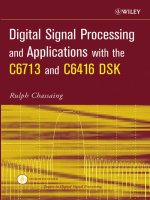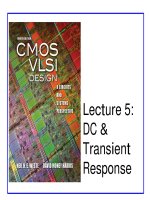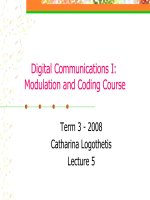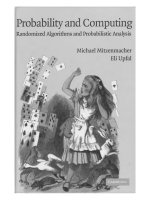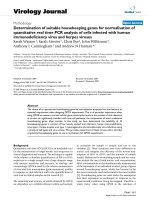LECTURE 5: MORE APPLICATIONS WITH PROBABILISTIC ANALYSIS, BINS AND BALLS ppsx
Bạn đang xem bản rút gọn của tài liệu. Xem và tải ngay bản đầy đủ của tài liệu tại đây (450.1 KB, 24 trang )
Probability in Computing
© 2010, Quoc Le & Van Nguyen
Probability for Computing 1
LECTURE 5: MORE APPLICATIONS WITH
PROBABILISTIC ANALYSIS, BINS AND BALLS
Agenda
Review: Coupon Collector’s problem
and Packet Sampling
Analysis of Quick
-
Sort
© 2010, Quoc Le & Van Nguyen
Probability for Computing 2
Analysis of Quick
-
Sort
Birthday Paradox and applications
The Bins and Balls Model
Coupon Collector Problem
Problem: Suppose that each box of cereal contains
one of n different coupons. Once you obtain one of
every type of coupon, you can send in for a prize.
Question: How many boxes of cereal must you buy
before obtaining at least one of every type of coupon.
© 2010, Quoc Le & Van Nguyen
Probability for Computing 3
before obtaining at least one of every type of coupon.
Let X be the number of boxes bought until at least
one of every type of coupon is obtained.
E[X] = nH(n) = nlnn
Application: Packet Sampling
Sampling packets on a router with probability p
The number of packets transmitted after the last sampled
packet until and including the next sampled packet is
geometrically distributed.
From the point of destination host, determining all
© 2010, Quoc Le & Van Nguyen
Probability for Computing 4
From the point of destination host, determining all
the routers on the path is like a coupon collector’s
problem.
If there’s n routers, then the expected number of
packets arrived before destination host knows all of
the routers on the path = nln(n).
DoS attack
© 2010, Quoc Le & Van Nguyen
Probability for Computing 5
IP traceback
Marking and
Reconstruction
Node append vs.
node sampling
© 2010, Quoc Le & Van Nguyen
Probability for Computing 6
node sampling
Node apend
A1
A2
A3
R5 R6
R7
D
D R6
© 2010, Quoc Le & Van Nguyen
Probability for Computing 7
V
R1
R2
R3
R4D R6 R3
D R6 R3 R2
D R6 R3 R2 R1
D R6 R3 R2 R1
Node Sampling
A
1
A
2
A
3
R
3
R
4
R
5
R
6
R
7
D1 R7
© 2010, Quoc Le & Van Nguyen
Probability for Computing 8
V
R
1
R
2
3
4
R2
p=0.51
D1 R2
x=0.2 < p
Expected Run-Time of
QuickSort
© 2010, Quoc Le & Van Nguyen
Probability for Computing 9
Analysis
Worst-case: n
2
.
Depends on how we choose the pivot.
Good pivot (divide the list in two nearly equal
length sub
-
lists) vs. Bad pivot.
© 2010, Quoc Le & Van Nguyen
Probability for Computing 10
length sub
-
lists) vs. Bad pivot.
In case of good pivot -> nlg(n). [by solving
recurrence]
If we choose pivot point randomly, we will
have a randomized version of QuickSort.
Analysis
X
ij
be a random variable that
Takes value 1 if y
i
and y
j
are compared with each other
0 if they are not compared.
E[X] = ∑∑E[X
ij
]
© 2010, Quoc Le & Van Nguyen
Probability for Computing 11
E[X] = ∑∑E[X
ij
]
E[X
ij
] = 2/ (j-i+1) (when we choose either i or j
from the set of Y
ij
pivots {y
i
, y
i+1
, …, y
j
}
Using k = j-i+1, we can compute E[X] = 2nln(n)
Detail analysis
© 2010, Quoc Le & Van Nguyen
Probability for Computing 12
What is the probability that
two persons in a room of
30 have the same
Birthday “Paradox”
© 2010, Quoc Le & Van Nguyen
Probability for Computing 13
30 have the same
birthday?
Birthday Paradox
Ways to assign k different birthdays
without duplicates:
N = 365 * 364 * * (365
–
k
+ 1)
© 2010, Quoc Le & Van Nguyen
Probability for Computing 14
N = 365 * 364 * * (365
–
k
+ 1)
= 365! / (365 – k)!
Ways to assign k different birthdays
with possible duplicates:
D = 365 * 365 * * 365 = 365
k
Birthday “Paradox”
Assuming real birthdays assigned randomly:
N/D = probability there are no duplicates
1 - N/D = probability there is a duplicate
© 2010, Quoc Le & Van Nguyen
Probability for Computing 15
= 1 – 365! / ((365 – k)!(365)
k
)
16
Generalizing Birthdays
P(n, k) = 1 – n!/(n-k)!n
k
Given
k
random selections from
n
possible
© 2010, Quoc Le & Van Nguyen
Probability for Computing 16
Given
k
random selections from
n
possible
values, P(n, k) gives the probability that there is
at least 1 duplicate.
Birthday Probabilities
P(no two match) = 1 –
P
(all are different)
P
(2 chosen from
N
are different)
= 1 – 1/
N
P
(3 are all different)
= (1
–
1/
N
)(1
–
2/
N
)
© 2010, Quoc Le & Van Nguyen
Probability for Computing 17
= (1
–
1/
N
)(1
–
2/
N
)
P
(
n
trials are all different)
= (1 – 1/
N
)(1 – 2/
N
) (1 – (
n
– 1)/
N
)
ln (
P
)
= ln (1 – 1/
N
) + ln (1 – 2/
N
) + ln (1 – (
k
– 1)/
N
)
Happy Birthday Bob!
ln (P) = ln (1 – 1/N) + + ln (1 – (k – 1)/N)
For 0 < x < 1: ln (1 – x) x
ln (P) – (1/N + 2/N + + (n – 1)/N)
Gauss says:
© 2010, Quoc Le & Van Nguyen
Probability for Computing 18
1 + 2 + 3 + 4 + + (n – 1) + n = ½ n (n + 1)
So,
ln (P) ½ (k-1) k/N
P e
½ (k-1)k / N
Probability of match 1 – e
½ (k-1)k / N
Applying Birthdays
P(n, k) > 1 – e
-k*(k-1)/2n
For n = 365, k = 20:
P(365, 20) > 1 – e
-20*(19)/2*365
P(365, 20) > .4058
© 2010, Quoc Le & Van Nguyen
Probability for Computing 19
P(365, 20) > .4058
For
n
= 2
64
,
k
= 2
32
:
P
(2
64
, 2
32
) > .39
For
n
= 2
64
,
k
= 2
33
:
P
(2
64
, 2
33
) > .86
For
n
= 2
64
,
k
= 2
34
:
P
(2
64
, 2
34
) > .9996
Application: Digital Signatures
Balls into Bins
We have m balls that are thrown into n bins,
with the location of each ball chosen
independently and uniformly at random from n
possibilities.
What does the distribution of the balls into the
bins look like
© 2010, Quoc Le & Van Nguyen
Probability for Computing 20
What does the distribution of the balls into the
bins look like
“Birthday paradox” question: is there a bin with at
least 2 balls
How many of the bins are empty?
How many balls are in the fullest bin?
Answers to these questions give solutions to
many problems in the design and analysis of
algorithms
The maximum load
When n balls are thrown independently and uniformly at
random into n bins, the probability that the maximum
load is more than 3 ln
n
/lnln
n
is at most 1/
n
for
n
sufficiently large.
By Union bound, Pr [bin 1 receives M balls]
Note that:
© 2010, Quoc Le & Van Nguyen
Probability for Computing 21
Note that:
Now, using Union bound again, Pr [ any ball receives M balls]
is at most
which is
1/n
Application: Bucket Sort
A sorting algorithm that
breaks the (nlogn) lower
bound under certain input
assumption
Bucket sort works as follows:
© 2010, Quoc Le & Van Nguyen
Probability for Computing 22
Bucket sort works as follows:
Set up an array of initially
empty "buckets."
Scatter: Go over the original
array, putting each object in its
bucket.
Sort each non-empty bucket.
Gather: Visit the buckets in
order and put all elements back
into the original array.
A set of n =2
m
integers,
randomly chosen from
[0,2
k
),km, can be sorted
in expected time O(n)
Why: will analyze later!
The Poisson Distribution
Consider m balls, n bins
Pr [ a given bin is empty] =
Let X
j
is a indicator r.v. that os 1 if bin j empty, 0 otherwise
Let X be a r.v. that represents # empty bins
© 2010, Quoc Le & Van Nguyen
Probability for Computing 23
Generalizing this argument, Pr [a given bin has r balls] =
Approximately,
So:
Limit of the Binomial Distribution
© 2010, Quoc Le & Van Nguyen
Probability for Computing 24

